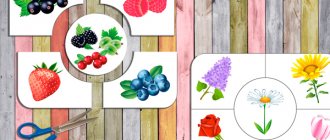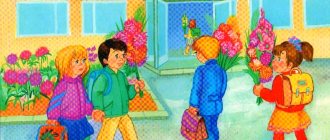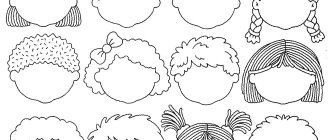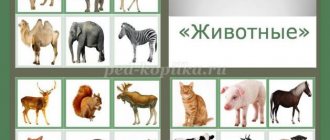Remember that time when your parents told you about the seasons? Hardly. It seems like we always knew this. Now the same task faces you: how to teach a child the seasons in such a way that he understands and remembers it for the rest of his life?
But before you start getting acquainted with the seasons, you should prepare, since a seemingly simple topic in practice turns out to be quite complex, the child has many questions, and all the material you have told should be reinforced with games and exercises, several examples of which you will find in this article .
At what age should you start learning the seasons?
Of course, even from infancy, you can tell a baby about the seasons, and perhaps this information will be deposited somewhere on a subconscious level, and it’s simply useful to conduct dialogues with babies, developing their auditory perception.
But for a conscious understanding, this topic should be addressed at the age of 18-24 months. At the same time, it is important not to unload all the knowledge you have on your child, but to begin to gradually introduce concepts such as “warm” and “cold”, “cloudy” and “sunny”, “rainy and dry”.
Discuss the weather before going for a walk and when you dress your baby - tell why now you need to put on rubber boots and not sandals, why you need a hat, etc. Simple phrases: “We’ll put on mittens so that our hands don’t freeze,” “We’ll put on our cheeks, so that the frost doesn’t bite”, “Let’s take a cap/hat with us so that your nose doesn’t burn” have their own associative power, which will lay the foundation for a better understanding of weather conditions. And, already using this information, you can tell your child about the seasons.
If at 18-24 months you did not have time to tell your baby about the seasons, it is important not to miss this moment at the age of 3-4 years. But in this case, the first stages of introducing conversations about the weather should be completed as soon as possible, and then proceed to more informative stories that allow you to clearly distinguish between the seasons and identify the differences between them.
Intertropical space.
In the low latitudes between the Northern and Southern Tropics, temperatures are always high and vary little from month to month. The annual temperature range (the difference between the temperatures of the warmest and coldest months) never exceeds 11° C, and near the equator it is less than 2° C. Seasonal differences are due to the distribution of precipitation. In such areas, with the exception of the equatorial strip itself, where there are no seasonal changes at all, winter corresponds to the dry season, and summer to the wet season.
How to teach seasons with children?
As already mentioned, starting from one and a half to two years, you can tell your child about the change of seasons. Start with something simple, for example, with associations: in winter - snow; in the spring it melts and the birds fly in; in summer - fruits, berries and the sea; In autumn, yellow leaves and birds fly south.
To get acquainted, you can not only tell, but also:
- Show pictures in books, cards, coloring books. Among the wide range of printed materials, there are many bright colorful copies, which not only depict the seasons, but also contain educational tasks and exercises. For kids, books about the seasons with “windows” will be interesting; for older children, labyrinths and coloring books will be fascinating.
- Draw, sculpt, glue. Select a plot in advance and discuss with your child what he wants to do. If your child is wrong about something, explain to him, for example, why you can’t draw a swan in winter or a snowman in summer.
- Watch educational cartoons for children. Among popular educational content, episodes about the seasons can be found in such animated series as “Three Cats”, “Little Babies”, “Peppa Pig”, “Derevyashki”, “Kukutiki”, “Be-Be-Bears School - The World Around You” and others .
- Guess riddles about the seasons that will help your child quickly remember the names and characteristics of the four seasons.
Children aged 5-6 years should already know the names of the seasons and their signs and be able to distinguish one from the other. And they could observe the process of changing seasons more than once with their own eyes. But you shouldn’t stop learning. At this age you can:
- Show a map of climate zones and tell them that the weather is not the same all over the world.
- Give examples and show pictures of countries and places on the planet where there is only summer or only winter all year round.
- Tell them that oranges grow in warm countries, and coniferous forests grow in cold tundra. You can also give examples with animals and explain that a kangaroo in Chukotka will be as uncomfortable as a polar bear in the Sahara.
- In addition, when studying the seasons, you can touch on another important topic - tell your child what time is and teach how to determine it by the clock.
Temperate latitudes
characterized by distinct seasonal temperature changes. The cold season is called winter, the warm season is called summer, and autumn and spring are transitional seasons. Temperate latitudes experience a wide variety of conditions. In some regions it is very hot in summer (from +32 to +38° C), in others it is cool (on average +10° C). Winters can be very mild (+4°C) or very cold (on average –23°C). Moreover, since contrasting arctic and subtropical air masses collide at these latitudes, the weather here is very unstable and changes quickly both from day to day and from year to year.
How to explain the change of seasons to a child?
So we have smoothly approached the very principle of the universe. Joke! Of course, you shouldn’t start the story with the “Big Bang,” but you will have to explain to your child what planet Earth and the solar system are, otherwise it’s unlikely that you’ll be able to tell how the seasons change and why there is no obvious change in the weather in certain places. is happening.
So, the story can begin with the fact that the Earth revolves around a large and hot star - the Sun. Thanks to a random coincidence, the planet is located at such a distance from the Sun that water on it does not evaporate due to high temperatures and does not freeze due to low temperatures, that is, at the “ideal distance” for creating life.
The Earth, like all the planets in the solar system, rotates around the Sun in an orbit due to the force of gravity. An orbit is like a road for a planet - each one has its own, so the planets never intersect. The road around the Sun is not round, but has an elongated shape, like an oval or, correctly speaking, an “ellipse”. One such “oval” of the Earth passes in exactly 365 days - that is, a year.
But in addition to revolving around the Sun, our planet also rotates around an imaginary axis (a line passing through the North and South Poles). If the Earth's axis were at right angles to the Earth's orbit, we would have no seasons and all days would be the same. But this axis is tilted relative to the Sun (at 23°27′). As a result, the Earth rotates around the Sun in an inclined position. This position persists all year round, and the Earth's axis is always directed to one point - the North Star.
Therefore, at different times of the year the Earth exposes its surface to the sun's rays in different ways. When the sun's rays fall directly, the sun is hotter and we experience spring, and then summer. If the rays of the Sun hit the earth's surface at an angle, then they heat the earth's surface less, and winter sets in.
Perhaps the child will have a question: “If the Earth is in a similar position during spring and autumn, why is there not only one spring?” Here it is worth talking about the fact that nature has adapted to the movement of the planet and before the onset of cold weather it “falls asleep” and this can be understood by:
- yellowing and falling leaves, as there is less heat and light, and in order for everything to be green, you need a lot of bright sun;
- animals go into hibernation, because it’s hard to find food under the snow, and it’s cold, and birds fly away to where it’s warm and there are a lot of insects;
- Daylight hours are getting shorter.
At the same time, feeling the warming, nature wakes up:
- the length of daylight hours increases;
- insects begin to fly, which are especially sensitive to temperature changes;
- the buds swell on the trees and the first flowers appear;
- birds arrive.
It is also worth mentioning that the change of seasons is not noticeable in every corner of the Earth. For example, in Antarctica and the North Pole there is always snow, since heat does not reach there well due to the tilt of the earth's axis. At the same time, it is always hot at the equator, because this part receives the most sunlight.
Differences between hemispheres.
The seasons in the Southern Hemisphere are exactly the opposite of those in the Northern Hemisphere. Summer in the Southern Hemisphere begins around December 22. However, there are some differences due to the eccentricity of the Earth's orbit. The winter solstice there occurs just a few days before the Earth reaches perihelion. At this time, the Earth as a whole receives more heat from the Sun than at aphelion, the point of its orbit furthest from the Sun. It would seem that it should follow from this that summers in the Southern Hemisphere are warmer than at the corresponding latitudes of the Northern Hemisphere, and winters are colder. However, in temperate latitudes the opposite relationship is often observed. The difference in the amount of heat received by the Earth at perihelion and aphelion is 6%, but due to the huge area of the oceans in the Southern Hemisphere, the climate changes more than as a result of the effect mentioned above.
Signs of the seasons for children
It is also worth telling your child that in each season there are three months, which are characterized by certain changes, weather, and some of everyone’s favorite holidays are celebrated. Before first grade, a preschooler should already know the sequence of seasons and name all 12 months.
Winter
Let's start with the coldest time of the year - winter and its months.
1. December
Although our calendar begins in January, the first winter month is December. At this time, parents dress their children in warm clothes and shoes. Everyone tries to stock up on gloves, because when sledding or playing in the snow, they quickly get wet. And in December the New Year comes, they put up a Christmas tree at home, decorate it with toys and give the children a lot of gifts and sweets. December 21 is the longest night and shortest day, after which it begins to gradually increase.
2. January
The first calendar month of the year. In January there is a lot of snow, which means that the birds that remained to spend the winter in their homeland have nothing to eat. At this time, you can feed them with crumbs, and for tits, hang a piece of lard. When the sun shines, the snow on the roof melts and beautiful transparent icicles form
3. February
The last winter month is characterized by severe frosts and snowstorms. Due to the low temperatures, many bodies of water freeze so hard that you can skate on them.
Spring
In spring, the long-awaited warmth comes, the snow melts, nature comes to life, and the days become longer.
1. March
This is the first month of spring. The sun's rays begin to warm up, the snow gradually melts, and the first flowers appear under it - snowdrops. The nights are getting shorter and the days are getting longer. International Women's Day is celebrated on March 8th. On this holiday, it is customary to give gifts, sweets and flowers to all mothers and girls. March 20 is also considered an unusual day, since it is on this date that the Earth occupies such a position in its orbit that the length of day and night is the same.
2. April
The sun is getting warmer and stronger, which means that on some warm days you can even take a walk without a hat. The days are already long enough that evening walks end later. This month many flowers bloom, the grass turns green, and leaves grow on the trees. In April, ants wake up, butterflies and other early insects begin to flutter.
3. May
The last month of spring. For many, it is even associated with summer, because the days are long, it gets dark late and the school year ends. In May, people no longer wear warm clothes, but they still don’t strip down to T-shirts. This month gets plenty of rain which is good for nature and greenery. But after the rain the sun often appears and quickly dries everything out. There are a lot of lilacs blooming in the parks, and May is also considered the most “musical” month of the year, because frogs wake up and birds sing even at night!
Summer
Summer is the hottest and favorite time of the year for many children.
1. June
The first month of summer and summer holidays. Children relax, go to the sea. It's warm outside and you can walk in light clothes, but be sure to cover your head from the warm rays of the sun. In June, fireflies wake up and grasshoppers and crickets begin to “play.” And on June 21st comes the longest day and the shortest night.
2. July
July is considered the hottest of the year. Most birds give birth to offspring this month. The first fruits and berries are ripening
3. August
The last month of summer is not as hot as the previous one, and the nights are already getting longer. Fruits are ripening in the gardens, the first harvests are beginning to be harvested in the fields: seeds, corn, wheat, etc., it may be cooler in the evenings, and therefore you need to take a jacket with you. In August, animals begin to prepare supplies for the winter.
Autumn
Autumn is often a cloudy and rainy season, but at the same time it is the brightest and richest in colorful colors.
1. September
The first day of autumn is considered the Day of Knowledge. At this time, children go to school and learn a lot of new and useful things there. The evenings become colder, and on September 22, day becomes equal to night. After this date, the night will become longer, until December 21st. In September it often rains, the mornings and evenings are cool, and during the day it can be hot, like in summer. Many mushrooms appear in the forest, and potatoes, beets and other vegetables are harvested in the fields.
2. October
This month the weather can change several times a day. The leaves on the trees turn yellow and fall off, it becomes cool, and parents take out demi-season jackets from the closet. Migratory birds fly south at the end of October, and animals complete their preparations for hibernation.
3. November
This month is considered the gloomiest - the sky is covered with heavy clouds, there is often wind during the day, and at the end of November there can be frost and even snow. There are no leaves on the trees anymore, and nature is completely asleep, preparing for the arrival of winter.
Day
Our planet Earth rotates not only around the sun, but also around its own axis, exposing first one side or the other to the sun. Where the planet is illuminated by the Sun, it is day. At this time, it is night on the other side of the planet. One revolution of our planet around its axis is a day.
DAY = DAY + NIGHT
In summer, the days are long and the nights are short. In winter, on the contrary, the days are short and the nights are long.
Remember what the sky looks like during the day and what it looks like at night. Draw day and night.
Here are children's riddles about time
And finally...
Children are very inquisitive at every age, and therefore parents should prepare for studying the seasons in advance, so that when the baby begins to have the first questions, an adult can answer them correctly, give examples, show these phenomena in nature and then consolidate everything with games and exercises .
Geography courses for children 6-13 years old
In the online course “Amazing Planet” we introduce children to the most important places in Russia and the world in a fun format through games, stories and riddles
find out more










